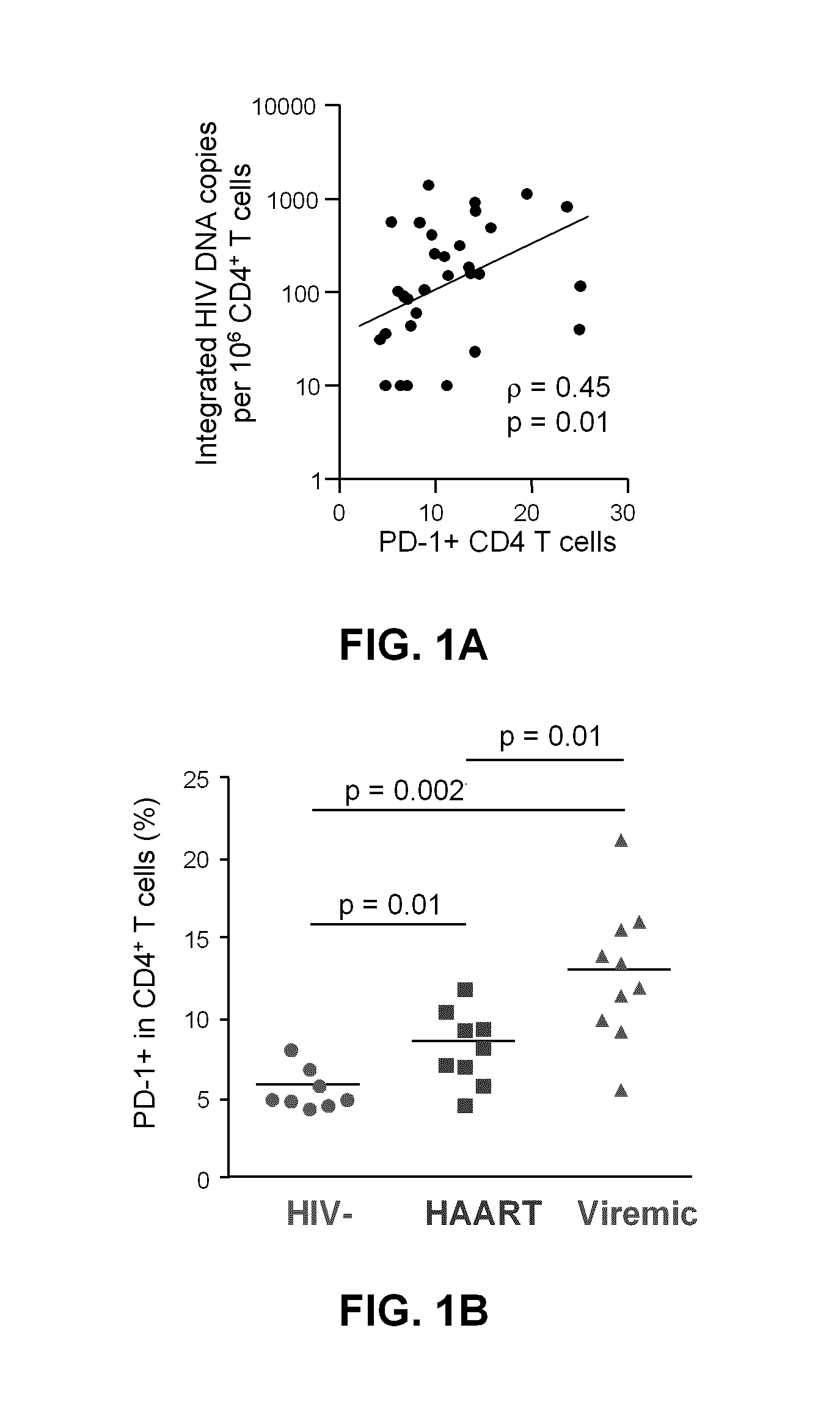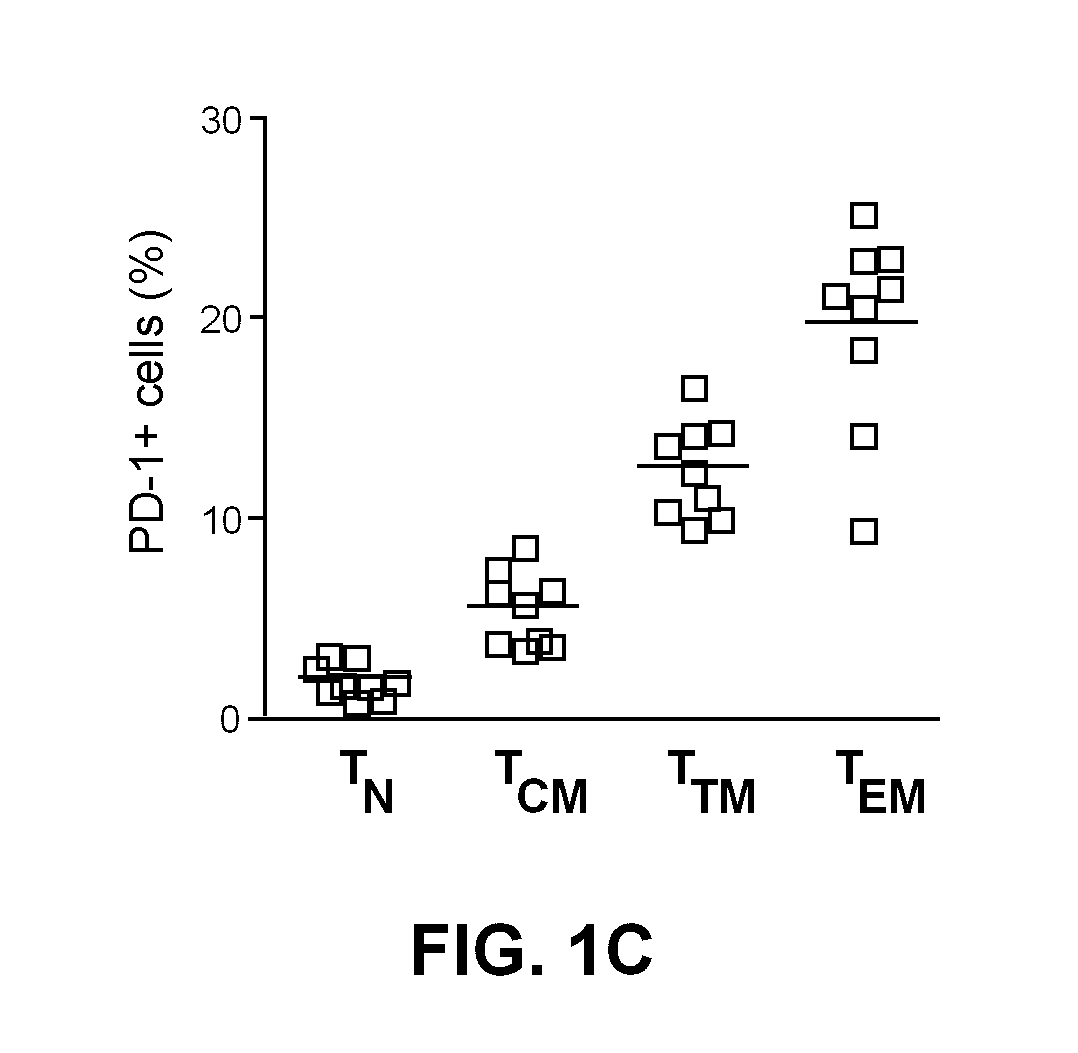Pd-1 modulation and uses thereof for modulating HIV replication
a technology modulation, which is applied in the field of modulation of human immunodeficiency virus (hiv) infection, can solve the problems of death of infected cells, haart regimens, and the like, and achieve the effects of eliminating latent hiv reservoirs, and reducing the number of latently hiv-infected cells
- Summary
- Abstract
- Description
- Claims
- Application Information
AI Technical Summary
Benefits of technology
Problems solved by technology
Method used
Image
Examples
example 1
Materials and Methods
[0147]Human Subjects.
[0148]Ten HIV-chronically infected subjects enrolled in this study and signed informed consent approved by the Royal Victoria Hospital and the CR-CHUM hospital review board. None of these subjects received antiretroviral therapy at the time of study. Plasma viremia were measured by the Amplicor™ HIV-1 monitor ultrasensitive Method (Roche). All subjects underwent leukapheresis to collect large numbers of PBMCs.
[0149]Stimulation of CD4+ T Cells.
[0150]PBMCs from HIV-infected donors were isolated from whole blood by density gradient centrifugation (Ficoll) and resuspended in RPMI supplemented with 10% Fetal Bovine Serum (FBS). CD4+ T cells were isolated by negative selection on a Robosep™ (Stemcell Technologies—EasySep™ Human CD4+ T cell enrichment kit, Cat. No. 19052). Purified CD4+ T cells (more than 90% pure, as determined by flow cytometry) were distributed at 1×106 cells / ml in 48 well plates in 1 ml of RPMI supplemented with 10% FBS and Pen...
example 2
PD-1 Expression in HIV-Infected Subjects
[0154]The results depicted in FIG. 1A show that there is a correlation between the frequency of CD4+ T cells expressing PD-1 and the frequency of CD4+ T cells harbouring integrated HIV DNA in HIV-infected subjects, suggesting that PD-1 expressing cells are more likely to harbour integrated HIV DNA. FIG. 1B demonstrates that the frequency of cells expressing PD-1 is increased during HIV infection, and cannot be normalized by HAART. The frequency of PD-1 expressing cells in various CD4 T cells subsets, namely naïve (CD45RA+ CCR7+ CD27+, TN), central memory (CD45RA− CCR7+ CD27+, TCM), transitional memory (CD45RA− CCR7+ CD27+, TTM) and effector memory (CD45RA− CCR7+ CD27−, TEM), from 9 virally suppressed subjects is shown in FIG. 1C, with TEM>TTM>TCM>TN.
[0155]The frequency of PD-1hi and PD-1lo cells harbouring HIV DNA and integrated HIV DNA in untreated HIV infected subjects and virally suppressed subjects is depicted in FIGS. 2A and 2B, respectiv...
example 3
PD-1 Triggering Inhibits HIV Replication in Primary CD4+ T Cells
[0156]The effect of PD-1 triggering on HIV replication was assessed in primary CD4+ T cells purified from 6 viremic donors (results from 4 donors are illustrated in FIG. 3A). CD4+ T cells were isolated by negative selection and stimulated with anti-CD3+anti-CD28 antibodies with or without co-triggering of PD-1 by the murine IgG2a human PD-L1 chimera. PD-1 triggering inhibited HIV replication in primary CD4+ T cells after 3, 6 and 9 days of stimulation (mean percentages of inhibition with PD-L1 relative to isotype control=95.3, 99.0 and 98.2% after 3, 6 and 9 days, respectively).
PUM
| Property | Measurement | Unit |
|---|---|---|
| pH | aaaaa | aaaaa |
| pH | aaaaa | aaaaa |
| thermal melting point | aaaaa | aaaaa |
Abstract
Description
Claims
Application Information
 Login to View More
Login to View More - R&D
- Intellectual Property
- Life Sciences
- Materials
- Tech Scout
- Unparalleled Data Quality
- Higher Quality Content
- 60% Fewer Hallucinations
Browse by: Latest US Patents, China's latest patents, Technical Efficacy Thesaurus, Application Domain, Technology Topic, Popular Technical Reports.
© 2025 PatSnap. All rights reserved.Legal|Privacy policy|Modern Slavery Act Transparency Statement|Sitemap|About US| Contact US: help@patsnap.com



